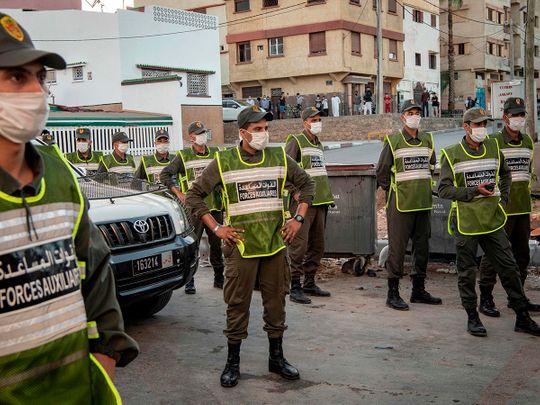
Abu Dhabi: Morocco’s Health Ministry has announced that 54 per cent of the country’s coronavirus infections since the outbreak began in March were reported in first 23 days of August, local media reported.
The figures put the country third highest in Africa for number of infections, behind South Africa and Egypt, and 49th globally. For COVID-19 fatalities the country is also 49th globally and fifth in Africa. It came in 31st place globally and second in Africa for the number of PCR tests it has carried out.
In a weekly briefing on the outbreak, the ministry said Tuesday it has reported 77 cases for every 100,000 people since the beginning of August. Some 60 per cent of deaths were reported during this period.
Mouad Mrabet, Coordinator of the National Centre for Public Health Emergency Operations at the Ministry of Health, said 52,349 infections have been confirmed, 888 deaths (or 1.7 per cent of cases) and recoveries have climbed to 36,343, at a rate of 69 per cent.
Between August 17 and 23, Mrabet said 9,860 cases were recorded, including 37 among travellers from abroad, with a weekly rate of 27 infections per 100,000 people. He said 230 deaths and 6,999 recoveries were registered during this period.
Last week has also seen an increase of nearly 6.6 per cent in the number of infection cases and 43.8 per cent in the number of deaths, he added.
Regarding the geographical distribution of COVID-19 infections in Morocco, Mrabet said 24 provinces recorded less than 10 infections per 100,000 inhabitants, while six provinces recorded more than 50 cases per 100,000 inhabitants.
The progression of COVID-19 in Africa may be following a different path to other parts of the world, according to the World Health Organization (WHO).
Six months after the first case was detected on the continent, the WHO says African nations may be seeing a more gradual rise in cases, rather than rapid surges as happened in other parts of the world.
The continent passed one million cases on 6 August, but the rate of increase has slowed.
In the week ending 16 August, the WHO Africa region (which excludes Morocco, Egypt, Sudan, Somalia, Djibouti, Tunisia and Libya) reported the largest decrease in new daily cases and deaths globally.
The growth in numbers of new cases was down by 27 per cent and in deaths by 21 per cent compared with the previous week, largely due to falling numbers in South Africa, Kenya, Algeria, Nigeria and Ghana.
However, Ethiopia reported a 56 per cent growth in new cases and a 12 per cent increase in deaths, with more than half of the cases in Addis Ababa. The country is running a mass testing campaign, aiming at conducting 400,000 tests in one month.
Other countries also experiencing big increases in cases are Eritrea, Rwanda, Uganda, Mali, Guinea-Bissau, Lesotho, Namibia and Malawi.
But the WHO says many countries are seeing gradual rises, making it difficult to indentify a specific peak.
It’s also warned that the coronavirus is moving from high-density urban areas to rural areas.
In terms of confirmed cases, Africa accounts for only a small proportion of the global total — just 5 per cent.
But the global humanitarian relief body, the International Rescue Committee, says it believes the true scale of the pandemic may be hidden because of a lack of testing and issues with data.
Where are Africa’s hotspots?
South Africa has the highest recorded number of total cases and reported deaths in Africa, and the fifth highest number of cases in the world.
Reported deaths appear lower compared with other countries in the world badly hit by coronavirus.








